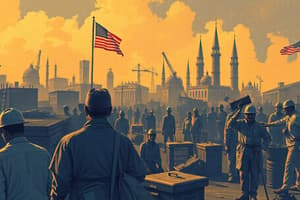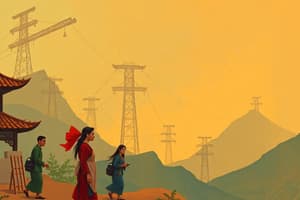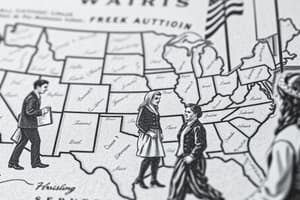Podcast
Questions and Answers
What types of jobs did many immigrants initially find in the United States?
What types of jobs did many immigrants initially find in the United States?
- Teachers and healthcare workers
- Construction workers and miners
- Shopkeepers and merchants
- Agricultural laborers and factory workers (correct)
Which three regions provided 70 percent of immigrants to the United States between 1820 and 1880?
Which three regions provided 70 percent of immigrants to the United States between 1820 and 1880?
- Poland, Russia, and Hungary
- Sweden, Norway, and Denmark
- Italy, France, and Spain
- Great Britain, Germany, and Ireland (correct)
What challenge did many immigrants face upon arriving in the United States?
What challenge did many immigrants face upon arriving in the United States?
- Immediate access to education
- Support from local governments
- Discrimination and hardship (correct)
- Free housing and healthcare
Who were the first Roman Catholics to arrive in large numbers in the U.S.?
Who were the first Roman Catholics to arrive in large numbers in the U.S.?
What was the primary motivation for steamship companies to depict the U.S. as a land of opportunity?
What was the primary motivation for steamship companies to depict the U.S. as a land of opportunity?
What sentiment did U.S. citizens express towards incoming immigrants, as demonstrated by Mayor Philip Hone?
What sentiment did U.S. citizens express towards incoming immigrants, as demonstrated by Mayor Philip Hone?
What industry offered jobs to immigrants who moved westward?
What industry offered jobs to immigrants who moved westward?
What can be inferred about the feelings of the Know-Nothing Party towards immigrants?
What can be inferred about the feelings of the Know-Nothing Party towards immigrants?
What significant agricultural disaster occurred in northwestern Europe in the late 1840s?
What significant agricultural disaster occurred in northwestern Europe in the late 1840s?
How many people did Ireland lose due to disease and starvation as a result of the blight?
How many people did Ireland lose due to disease and starvation as a result of the blight?
What was one of the main factors contributing to the massive immigration to the United States during the 1800s?
What was one of the main factors contributing to the massive immigration to the United States during the 1800s?
What major demographic change occurred across Europe due to the Industrial Revolution?
What major demographic change occurred across Europe due to the Industrial Revolution?
What characterized the United States by 1848 in terms of its geographical and economic status?
What characterized the United States by 1848 in terms of its geographical and economic status?
What was a consequence of the soaring population in Europe during industrialization?
What was a consequence of the soaring population in Europe during industrialization?
What primarily influenced the roots of the generation that authored the Declaration of Independence?
What primarily influenced the roots of the generation that authored the Declaration of Independence?
Which event primarily affected the Irish population during the late 1840s?
Which event primarily affected the Irish population during the late 1840s?
What was the main goal of the Naturalization Act of 1790?
What was the main goal of the Naturalization Act of 1790?
What option best describes the immigrant situation in the United States during the 1800s?
What option best describes the immigrant situation in the United States during the 1800s?
Which statement best describes the United States’ stance on citizenship and immigration as defined by the Constitution?
Which statement best describes the United States’ stance on citizenship and immigration as defined by the Constitution?
Which group was notably excluded from the possibility of citizenship under the Naturalization Act of 1790?
Which group was notably excluded from the possibility of citizenship under the Naturalization Act of 1790?
Before 1820, what practice did the United States neglect regarding newcomers?
Before 1820, what practice did the United States neglect regarding newcomers?
What does the term 'immigration' specifically refer to in this context?
What does the term 'immigration' specifically refer to in this context?
How did the authors of the Declaration of Independence view America's role for immigrants?
How did the authors of the Declaration of Independence view America's role for immigrants?
What was a limitation imposed by the Naturalization Act of 1790 regarding moral character?
What was a limitation imposed by the Naturalization Act of 1790 regarding moral character?
What characteristic defined the global struggle during the Cold War?
What characteristic defined the global struggle during the Cold War?
What was a consequence of the U.S. emerging as the most powerful country post-war?
What was a consequence of the U.S. emerging as the most powerful country post-war?
Which group faced exclusion from U.S. refugee admission in the late 1940s?
Which group faced exclusion from U.S. refugee admission in the late 1940s?
What impact did the Immigration and Nationality Act of 1952 have on Asian immigration?
What impact did the Immigration and Nationality Act of 1952 have on Asian immigration?
Which of the following statements best summarizes the U.S. role after emerging from the war?
Which of the following statements best summarizes the U.S. role after emerging from the war?
In which global region were the most refugees denied admission due to political reasons?
In which global region were the most refugees denied admission due to political reasons?
What was a factor influencing U.S. immigration policies concerning refugees?
What was a factor influencing U.S. immigration policies concerning refugees?
What was the main theme of the international commitments taken by U.S. leaders in the late 1940s?
What was the main theme of the international commitments taken by U.S. leaders in the late 1940s?
What group constitutes a significant portion of immigrants in the United States over the last two decades?
What group constitutes a significant portion of immigrants in the United States over the last two decades?
Which countries have contributed a large number of educated immigrants to the U.S. workforce?
Which countries have contributed a large number of educated immigrants to the U.S. workforce?
What legislative act aimed to address the rise in refugee admissions in the U.S. during the late 1970s?
What legislative act aimed to address the rise in refugee admissions in the U.S. during the late 1970s?
What was a key objective of the Immigration Reform and Control Act of 1986?
What was a key objective of the Immigration Reform and Control Act of 1986?
Approximately how many undocumented immigrants were estimated to have settled in the U.S. in 2009?
Approximately how many undocumented immigrants were estimated to have settled in the U.S. in 2009?
What was the estimated number of refugees and asylum seekers among immigrants in the U.S. in 2009?
What was the estimated number of refugees and asylum seekers among immigrants in the U.S. in 2009?
What kind of immigration status do the majority of non-U.S. citizens in the United States hold?
What kind of immigration status do the majority of non-U.S. citizens in the United States hold?
What issue did the Refugee Act of 1980 particularly address?
What issue did the Refugee Act of 1980 particularly address?
Flashcards are hidden until you start studying
Study Notes
Immigration in the U.S.
- The U.S. Constitution makes Congress responsible for immigration and citizenship issues.
- The Naturalization Act of 1790 limited citizenship to free white people with good moral character.
- The U.S. didn't count immigrants until 1820.
- The Industrial Revolution and agricultural shifts in Europe led to a population surge and widespread poverty.
- The Irish potato blight in the late 1840s caused widespread famine and emigration to the U.S.
- The U.S. expanded across the continent in the 1800s, with factories and abundant farmland attracting immigrants.
- Railroad companies actively recruited European laborers, and steamship companies marketed the U.S. as a land of opportunity.
- Between 1820 and 1880, 70% of immigrants to the U.S. were from Great Britain, Germany, and Ireland.
- The Irish were the first large Roman Catholic immigrant group to arrive in the mostly Protestant U.S.
- The Know-Nothing Party was a political party that expressed anti-immigrant sentiment and sought to restrict immigration.
- The U.S. emerged from World War II as the most powerful nation, taking on new international commitments to counter the Soviet Union.
- The Cold War redefined the U.S. role in the world, as the country took on a global fight for political and military dominance.
- The 1952 Immigration and Nationality Act eased restrictions on immigration from Asia.
- The 1965 Immigration and Nationality Act abolished national origin quotas, leading to a shift in the origins of immigrants to the U.S.
- Recent immigrants to the U.S. are more highly educated than previous generations with many coming from China, India, the Philippines, and Korea.
- In the 1990s, 1.6 million college-educated immigrants joined the U.S. workforce, nearly 50% of them from Asia.
- The U.S. government estimates that around 350,000 undocumented immigrants and 170,000 refugees or asylum seekers arrived in 2009.
- The Refugee Act of 1980 established a more consistent refugee policy, allowing for both regular and emergency refugee admissions.
- The 1986 Immigration Reform and Control Act aimed to reduce undocumented immigration by imposing penalties on employers who knowingly hired undocumented workers.
Contemporary Immigration
- The U.S. continues to experience a significant influx of immigrants, including those from war-torn countries in the Middle East and Africa.
- Many immigrants arrive as refugees or asylum-seekers, fleeing political instability, religious persecution, or ethnic conflicts.
- The U.S. government provides legal status to reside, study, work, or travel through visas and green cards.
Studying That Suits You
Use AI to generate personalized quizzes and flashcards to suit your learning preferences.




